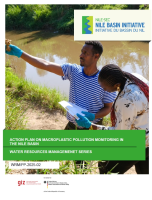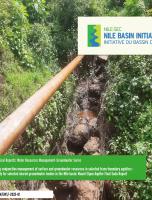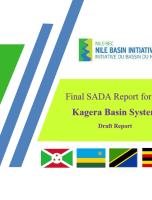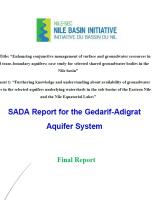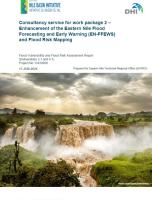Abstract
One of the important aspects of sustainable water resources management is addressing the challenges of equitable water allocation for transboundary water bodies such as rivers, lakes and groundwater sources. The Nile River, which is considered the longest river in the world crossesmultiple countries before it drains to the Mediterranean Sea. The management challenges that come with the transboundary nature of the river required the establishment of a River Basin Initiative
(NBI), which is a partnership of 10 riparian states with the objective “to achieve sustainable socioeconomic development through the equitable utilization of, and benefit from, the common Nile
Basin water resources” (www.nilebasin.org).According to UN (2017), population in the basin countries is projected to reach 0.9 to 1.1 billion inhabitants. Currently, about 40% of the population in Africa lives in urban areas, and it is expected to grow to about 60% by 2050 (UN-HABITAT and UNEP, 2010). It is conceivable to see competing demand for water for different sector in the future. Climate change may result in additional stress to the region beyond the population growth. Recognizing the importance of potential impact of climate change, NBI has explicitly addresses this challenge in their 10-year strategic plan with Goal 5 identifying two primary areas: “a) Provision of well vetted climate change projection data at appropriate spatial and temporal resolution for key target end users; and b) provision of scenarios of hydrology of the Nile Basin for various climate change projections.” (This current work). Careful assessment and production of actionable relevant climate projection data that is spatially and temporally consistent with the impact assessment objective is the first step in understanding climate change impact for a region. These assessments are cornerstone for charting potential
adaptation pathways.
Statement of the problem and objectives
Water scarcity is expected to be one of the great challenges facing many regions, including Africa. According to the 2030 Water Resources Group (2030wrg.org) current global water withdrawal for different uses exceeds the existing accessible, reliable, and sustainable supply of water. Assuming an average economic growth scenario and no efficiency gains (through conservation measures or those realized by passive or active efficiency measures), by 2030, the water withdrawal is expected to grow significantly with approximately a 40% deficit in water availability. Based on such predictions, nearly half of the world’s population is projected to live under severe water stress, especially areas in North and South Africa and South and Central Asia.
While these projections indicate serious challenges to sustainable water supply, some progressive approaches have been developed to address them, such as the Integrated Water Resources management (IWRM). A successful IWRM would have an adaptation strategy to alleviate impact of climate change on water resource. This will depend on developing decision support tools that incorporate water resource management tools that in turn would depend on credible-consistent future climate projection data in order to have a realistic scenario that is actionable.The objective of this project is to prepare bias corrected and downscaled climate change projections data appropriate for select targeted end-users in the Nile basin
Page 4 of 76
The specific objectives include:
I. Selection of GCMs that are informative and representative for impact study in the Nile Basin Countries
II. Development of bias corrected downscaled data that is actionable for specific type of end use such as water resources planning, flood mitigation, and drought analysis,
III. Development of data guide for method and tools used, and IV. Training NBI staff in downscaling and bias correcting to build internal capacity
